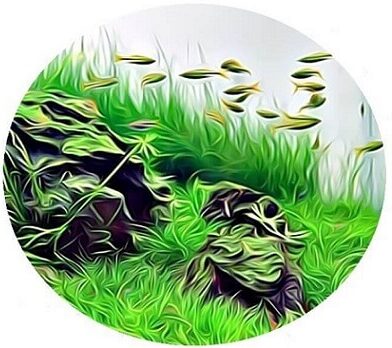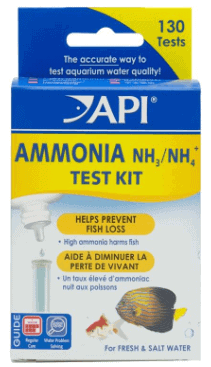Ammonia fish tank
Introduction
Ammonia is a substance generated by food scraps decomposition, fish urine, feces, and dead fish decomposition.
This substance, often overlooked, silently threatens the delicate ecosystems of our fish tank.
Ammonia is an invisible Killer!
Its presence poses a lethal danger to aquatic life. As a potent toxin, its accumulation in the fish tank water manifests symptoms ranging from subtle distress to outright fatality among fish, shrimps, and other inhabitants.
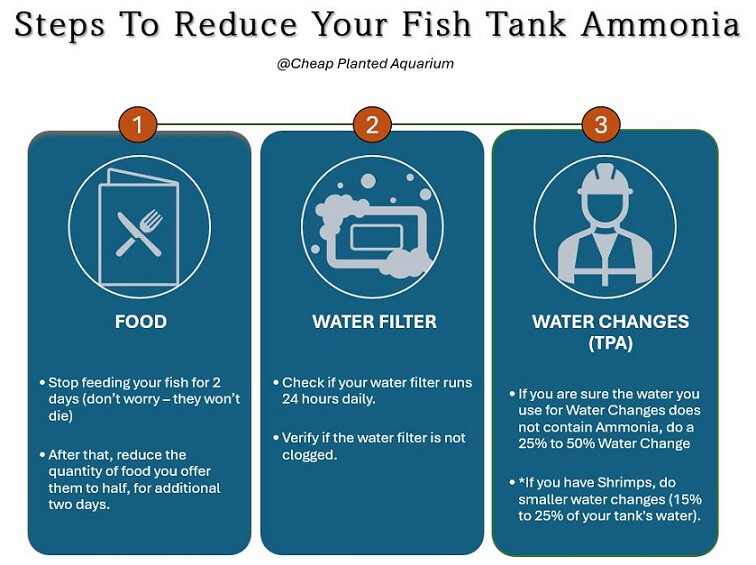
Understanding the signs of ammonia poisoning and implementing effective testing and mitigation strategies are critical for maintaining a healthy aquatic environment.
In this article, we will look at the nuances of ammonia management, offering insights into testing techniques, acceptable levels, and practical solutions for addressing ammonia spikes.
Table of Content
What is Ammonia?
Ammonia is a substance generated by food scraps decomposition, fish urine, feces, and dead fish decomposition.
“All animals excrete waste in the process of metabolizing food into the energy, nutrients, and proteins they use for survival and growth. In fish, this primary metabolic waste product is ammonia. Fertilizers and the decay of uneaten feed and organic matter contribute to ammonia, but in most aquaculture or hobbyist systems, the digestion of the feed eaten by the fish is the primary source of the compound. The more feed a fish is fed, the more ammonia the fish will produce. However, even a starved fish will produce some ammonia.””(1)
(1) (AMMONIA IN AQUATIC SYSTEMS Ruth Francis-Floyd, Craig Watson, Denise Petty, and Deborah B. Pouder)
The problem with ammonia accumulation in the fish tank’s water is that Ammonia is a very harmful and toxic substance.
How is Ammonia processed in nature?
Ammonia is processed in nature (in ponds, lakes, and rivers) through tons of aerobic bacteria that transform Ammonia into Nitrites. These bacteria (Nitrosomonas) feed on the energy released by the reaction (chemical reaction).
Nitrites are also quite harmful to fish. Fortunately, another group of also aerobic bacteria called Nitrobacter oxidizes nitrites into nitrates.
Again, these bacteria feed on the energy released by the reaction.
Finally, the nitrates formed by this process are less harmful than Ammonia or Nitrites. Plants and Algae consume Nitrates, keeping their levels low.
How is Ammonia processed in a fish tank ?
Ammonia is processed in a fish tank through good bacteria. We need to grow these bacteria in our tank’s water so they will consume the Ammonia and Nitrite.
The time required for such bacteria colonies to establish themselves in our tank varies with several factors such as temperature, type of substrate, pH, and oxygen content of the water.
It can take about 10 to 15 days for the ammonia-consuming bacteria to establish themselves and start acting. When this happens, nitrite levels rise (Ammonia becomes Nitrite) and reach their maximum by the 15th day.
Now It’s time for the other colony of bacteria to start growing and turning the nitrites into nitrates.
Note that, under normal conditions, nitrates rise, exceeding the concentration of nitrites between 20 and 25 days.
By now, Ammonia and Nitrites should be under control.
What are the symptoms of Ammonia Poisoning?
The symptoms of ammonia poisoning on fish and other inhabitants organism are many and often lead to death.
Ammonia enters the organism through the gills and changes the pH of the blood, thus altering the entire metabolism of the fish.
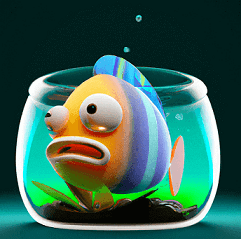
The main symptoms of intoxication are wheezing, hyperactivity, loss of balance (fish swim by falling on their side), inflammation of the gills, irritation of external tissues, eyes, and even heart rate acceleration.
Ammonia causes death.
Ammonia Management
Ammonia in a newly built fish tank
High ammonia levels are expected in a newly built fish tank because your new fish tank has yet to be cycled or is being cycled.
When cycling your fish tank (read more about cycling here), you must have Ammonia in the water, as this substance promotes the development of good bacteria.
Some people actually drop Ammonia in the water to accelerate the water cycling.
The ammonia level should decrease and down in a couple of days, indicating your fish tank is almost cycled (read more here).
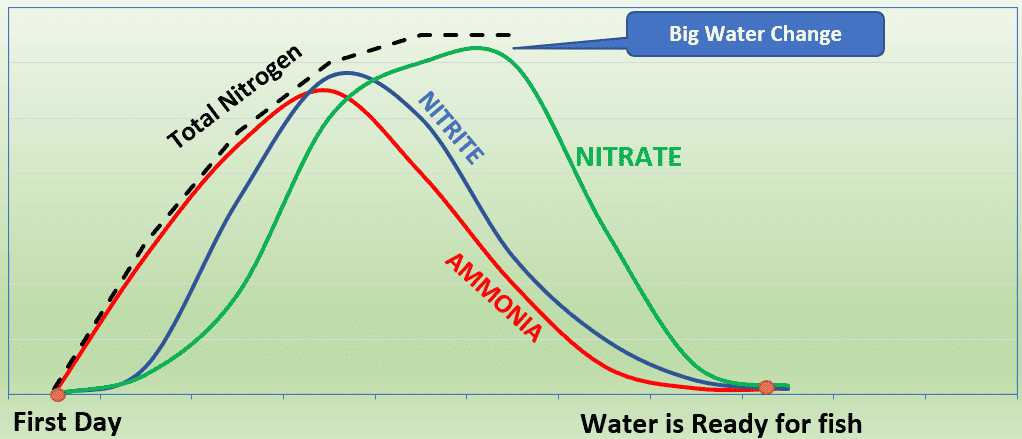
Ammonia in a pre-established fish tank?
If your fish tank is under four months old and you see high levels of Ammonia (above 0.25 ppm), this is generally nothing to worry about.
Sporadic Ammonia Spikes happen frequently with new fish tank setups.
In cases like this:
- Check if your water filter runs all the time, 24 hours daily.
- Verify if the water filter is not clogged.
- Stop feeding your fish for 2 days and after that, reduce the quantity of food you offer them to half, for additional two days (don’t worry; they won’t die).
- Check if you are not overfeeding your fish (read about how much to feed your fish here) (this is the most common reason).
- If you are sure the water you use for Water Changes does not contain Ammonia, do a 25% to 50% Water Change. If you have Shrimps, do smaller water changes (15% to 25% of your tank’s water).
Recheck your Ammonia levels after 2 days.
If the high level is still present after 2 or 3 days, something is wrong with the aquarium’s biological filtration, and it needs to be addressed.

Ammonia Spikes
Bad things happen; sometimes, you could have an Ammonia spike and need to lower ammonia levels.
In situations like that, first of all, stop feeding your fish for 2 days and after that, reduce the quantity of food you offer them to half, for two extra days (don’t worry; they won’t die).
If you are sure the water you use for Water Changes does not contain Ammonia, do a 25% to 50% Water Change. If you have Shrimps, do smaller water changes (15% to 25% of your tank’s water).
You can use aquarium-specific products that convert the Ammonia into something safe for your fish and other inhabitants. This is a short-term solution!
For this emergency action, I recommend you use Seachem Prime.
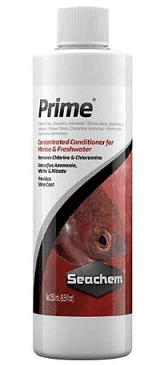
Follow the instructions provided by the manufacturer.
Using these water conditioners is a safety measure and will not fix why your ammonia is high; sooner or later, your Ammonia will increase again.
One thing is to reduce the Ammonia level now as an emergency action, but if you don’t handle the cause of the issue, the Ammonia will rise again.
Check if you are not overfeeding and if your water filter is working as expected).
Why you stop feeding your fish for 2 days and reduce the quantity of food for two extra days?
You will notice I am recommending you stop feeding your fish for two days and then reduce the quantity of food you offer them to half for two extra days.
Overfeeding is a major cause of high ammonia concentrations, and stopping the feeding will allow the nitrogen cycle (read more about the nitrogen cycle here) to “catch up” with the nutrient load.
What are the acceptable ammonia levels in freshwater aquariums?
Acceptable Ammonia Level in an Aquarium
The acceptable ammonia level in an aquarium is about zero. Above that, it starts to intoxicate the fish and other inhabitants.
At low concentrations, Ammonia causes stress and damages gills and other tissues. Fish exposed to low levels of ammonia over time are more susceptible to bacterial infections, have poor growth, and will not tolerate routine handling as well as they otherwise would.
Ammonia toxicity is ten times greater at a pH of 8.0 than it is at a pH of 7.0, so don’t be surprised to see fish dying with 0.10 ppm of Ammonia in a tank with a pH of 8.0.
Is 0.25 Ammonia harmful to fish?
Ammonia levels around 0.25 are toxic. Anything above 0 is considered harmful. Remember the relation between ammonia and pH mentioned above.
Is 0.50 ppm Ammonia bad?
A 0.50 ppm ammonia level is bad for fish, but you can fix it! Anything above 0 or even 0.1 is toxic.
Remember the relation between ammonia and pH mentioned above.
How to Measure your fish tank Ammonia levels
Ammonia Test for Fish Tank
The only way to test the ammonia level of your fish tank water is using a chemical test kit like this one from API.
If you are Color-blind and have difficulty seeing these water test results because they use colors, jump to this topic, where I give you a suggestion on how to handle it.
How often do you check ammonia levels in a fish tank?
You should test for the presence of Ammonia in your fish tank once a week in any new tank or fish tank less than four months old.
You should test your water once a month for more mature fish tanks.
Ammonia (and other water quality parameters) should be tested immediately when fish appearance or behavior changes (including reduced feeding).
Step-by-Step: Using the Ammonia Test Kit
I made this short step-by-step video showing you how to test your fish tank ammonia.
If you are Color-blind and are have difficulty seeing these water test results as they use colors. Jump to this topic where I give you a suggestion on how to handle it.
How to lower ammonia levels in an aquarium?
Keeping your ammonia level under control
To keep your ammonia levels under control, make sure you do and are doing:
- Feed your fish correctly: feed only what they can eat in 2 or 3 minutes. If you are unsure how much, start with a tiny quantity and observe how fast they eat. Give them a little more if it is completely consumed in less than 2 minutes.
- Check if your water filter capacity is adequate for your tank size.
- Clean your filter and keep a cleaning routine. It could be once per month, once every two months, and so on.
- Increase your water changes (called TPA) frequency for some weeks.
- Ensure the water you use during your water changes is free of Ammonia.
- Is your tank cycled? Please read this article, where I explain how to increase the number of good bacteria that will consume Ammonia.
- Check if your tank is not overcrowded using my “How Many Fish in a Tank” Online Calculator to help you to figure out how many of them you can have in your tank”.
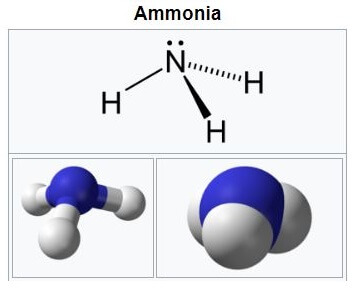
References
Wikipedia has an amazing article about Ammonia in general. It is here.
The Florida Department of Agriculture also has a very good article about Ammonia here.
Ammonia in Aquatic Systems by Ruth Francis-Floyd, Craig Watson, Denise Petty, and Deborah B. Pouder – UF IFAS Extension – University of Florida – here.
If you have questions or suggestions, reach out to me here.
